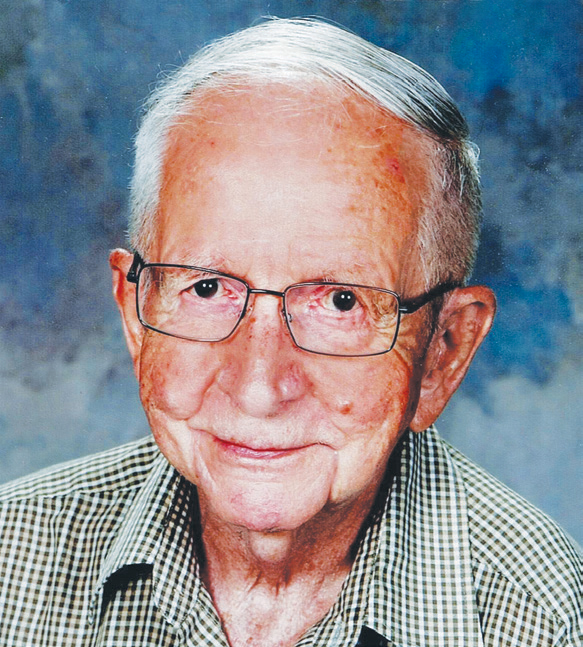Dr Roger Page, 1933–2023

Dr Roger Hubert Vincent Page died peacefully in Ridge Meadows Hospital in Maple Ridge on 23 September 2023, a few days after his 90th birthday.
Roger was the second of four children born into a family who farmed in Matsqui, near Abbotsford. He is survived by his younger twin siblings: Merrill, a rancher in Barriere, and Marion, a retired nurse living in Menno Home in Abbotsford.
Roger worked on the farm with his family but from an early age set his sights on becoming a doctor. His cohort was one of the first graduating classes of the UBC Faculty of Medicine. He completed his residency at St. Paul’s Hospital in Vancouver and later undertook extra training in surgery to better equip him for working in remote areas. Among his vacation jobs as a student were two summers in Yukon as a deckhand on a tourist riverboat. One task he joked about was sneaking onto the beaches ahead of the tourists to plant gold nuggets in the fields for them to find.
Roger was deeply religious. He took up a position in Bella Bella, a small island on BC’s Central Coast, in the R.W. Large Memorial Hospital (renamed ƛ̓uxv‡l‡su̓ilas Heiltsuk Hospital), which was established by the Methodist Mission (later the United Church). This was the only hospital west of Williams Lake in the Cariboo. He traveled annually up and down the Central Coast on the Thomas Crosby mission ship, providing medical services to many Indigenous communities, as well as to remote logging camps and commercial fishing establishments. He was often the only doctor in the hospital in Bella Bella. In those days, evacuation of sick and injured people from remote communities was difficult. Roger had to undertake major emergency surgeries in the Bella Bella hospital; he would anesthetize the patient and perform the surgery with nursing assistance. He gained the trust and friendship of many people along the Central Coast—friendships that endured for years.
After a number of years, he moved to the small town of Terrace, where he worked as a family physician and helped staff the hospital, as did all the local doctors. He did ward rounds on his patients, delivered many babies, assisted in the operating room, and took his turn in the emergency department. He was much appreciated by his patients for the care he provided. He was knowledgeable and experienced and made thorough assessments in a relaxed and friendly fashion.
While living in Terrace, he traveled a couple of times a year, on his own time, to the remote northwest BC communities of Iskut, Dease Lake, and Telegraph Creek, each of which had clinics staffed by excellent federal nurses but no visiting doctors. The volunteer medical services he provided in his relaxed and friendly manner made him many friends among the local Indigenous people.
In the mid-1980s, Roger moved to Vancouver, where he worked with WorksafeBC for a while, followed by a 6-month period at the G.F. Strong Rehabilitation Centre. He continued visiting Terrace to do locums for some years.
Roger enjoyed many holidays to Mexico. He appreciated the Hispanic language and culture, and his visits to the country became lengthier over time. He rented accommodation away from the tourist areas, living among Mexican families; he learned to speak Spanish, even attending university courses in the language. He helped many families with medical problems, both with advice and financially. At one time he and BC friends cooperated in gathering secondhand wheelchairs, which, after many bureaucratic problems, they drove to Mexico in a truck and distributed among people in need.
Around 2000, Roger retired to Maple Ridge, close to his roots. As he aged and became less able to travel to Mexico, Roger discovered the large community of Mexican migrant farm workers on his doorstep, and they became his new family. His weekly routine was to visit the surrounding thrift shops, buying up suitcases, backpacks, clothing, rain gear, bicycles, and anything else that would make the workers’ lives more comfortable. When they returned to their families in Mexico at the end of each season, he sent them with suitcases of clothing for their children.
Roger was a man of deep faith, from early days in Matsqui to his final church home at Haney Presbyterian Church. He studied his Bible, encouraged and prayed for others, and lived out his faith. As a friend and driver for the Mexican workers, on Sundays he would worship with them at the Catholic or Pentecostal churches as well as his home Presbyterian church.
Roger’s health declined over the past few years. He was hospitalized with various ailments including three separate bouts of COVID-19, but he was always determined to get back on his feet. His final hospitalization, after a heart attack, pneumonia, and a fall, lasted 2 weeks, when he died peacefully in his sleep. Our thanks to Dr Lee and the nursing staff at Ridge Meadows Hospital for their excellent care and to the many friends who visited to encourage him in his last days. There was no funeral service, at his request. A celebration of life held for him a few weeks after his death was attended by many friends from many walks of his life.
—Gillian Hodge, MD
Maple Ridge
hidden
 |
| This work is licensed under a Creative Commons Attribution-NonCommercial-NoDerivatives 4.0 International License. |
